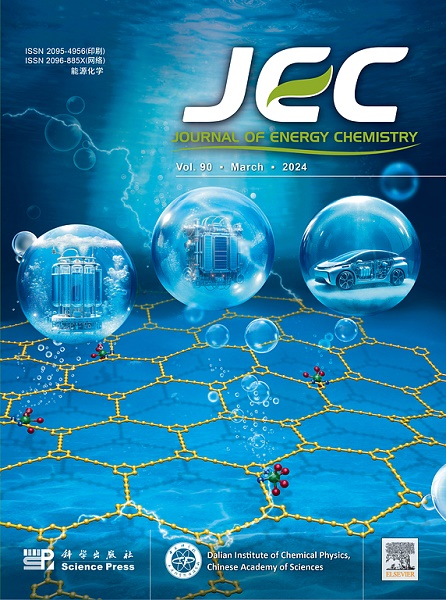Ionic liquids-assisted in-situ targeted defect-healing strategy for high-performance sprayed perovskite modules
IF 13.1
1区 化学
Q1 Energy
引用次数: 0
Abstract
In the process of spraying coating perovskite films, the “coffee ring” effect (CRE) leads to the problem of excessive organic ammonium salt accumulation in local areas that cannot be completely eliminated. We introduce an in-situ targeted defect-healing strategy by incorporating butylamine formate (BAFa) ionic liquid into the spray ink. Ionic liquids, due to their long carbon chain structure, tend to target flow towards the CRE region during the droplet evaporation process. The coordination between the lone pair electrons in the C![]() O group of BAFa and Pb2+ effectively reduces defects in perovskite and suppresses non-radiative recombination losses. Simultaneously, amine ligands, which are repelled to the film surface and grain boundaries, form a thin insulating monolayer in the CRE areas, forcing charge carriers to transport through areas of the perovskite with fewer defects. This approach enables the crystallization control and defect-heal over the Cs0.19FA0.81PbI3-x-yBrxCly perovskite films. Consequently, the champion perovskite solar cell achieved a power conversion efficiency of 22.04%, while mini-modules with an effective area of 64.8 cm2 reached a peak power conversion efficiency of 18.35%, demonstrating the significant potential for commercializing large-area perovskite solar cells.
O group of BAFa and Pb2+ effectively reduces defects in perovskite and suppresses non-radiative recombination losses. Simultaneously, amine ligands, which are repelled to the film surface and grain boundaries, form a thin insulating monolayer in the CRE areas, forcing charge carriers to transport through areas of the perovskite with fewer defects. This approach enables the crystallization control and defect-heal over the Cs0.19FA0.81PbI3-x-yBrxCly perovskite films. Consequently, the champion perovskite solar cell achieved a power conversion efficiency of 22.04%, while mini-modules with an effective area of 64.8 cm2 reached a peak power conversion efficiency of 18.35%, demonstrating the significant potential for commercializing large-area perovskite solar cells.

求助全文
约1分钟内获得全文
求助全文
来源期刊

Journal of Energy Chemistry
CHEMISTRY, APPLIED-CHEMISTRY, PHYSICAL
CiteScore
19.10
自引率
8.40%
发文量
3631
审稿时长
15 days
期刊介绍:
The Journal of Energy Chemistry, the official publication of Science Press and the Dalian Institute of Chemical Physics, Chinese Academy of Sciences, serves as a platform for reporting creative research and innovative applications in energy chemistry. It mainly reports on creative researches and innovative applications of chemical conversions of fossil energy, carbon dioxide, electrochemical energy and hydrogen energy, as well as the conversions of biomass and solar energy related with chemical issues to promote academic exchanges in the field of energy chemistry and to accelerate the exploration, research and development of energy science and technologies.
This journal focuses on original research papers covering various topics within energy chemistry worldwide, including:
Optimized utilization of fossil energy
Hydrogen energy
Conversion and storage of electrochemical energy
Capture, storage, and chemical conversion of carbon dioxide
Materials and nanotechnologies for energy conversion and storage
Chemistry in biomass conversion
Chemistry in the utilization of solar energy
 求助内容:
求助内容: 应助结果提醒方式:
应助结果提醒方式:


